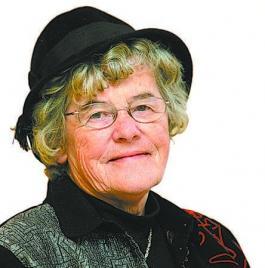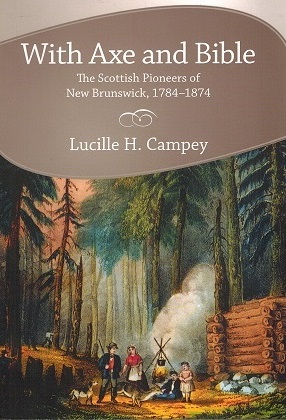
Ruby M. Cusack

With Axe and Bible
The Scottish Pioneers of New Brunswick, 1784-1874 by Lucille H. Campey
The Scottish Pioneers of New Brunswick, 1784-1874 by Lucille H. Campey
When Gramp and Dad were involved in a project, they forgot all about manners. They didn’t say “Please” but simply, “Go Get”.
Today, while working on splitting some hardwood, Dad broke the handle of his axe. Although Cliff and I were on the other side of the yard, Dad yelled, “Go get me my Campbell double-bitted axe that is in the horse barn.|”
We ran to the barn and looked at several axes but we didn’t have a clue what he meant by a Campbell double-bitted axe. The word “bit” to me meant something metal that was put in the horse’s mouth when a bridle was put on or maybe a part of the tool called a brace and bit. Cliff thought maybe it was a Camel shape or some reason like that for its name.
I made a choice, hoping I was right, and carried the axe to the men.
Gramp had such a look of disgust on his face while Dad hurried to the barn, I knew I had made the wrong decision, especially as Gramp mumbled, “That is a Spiller broad axe.”
Lucille H. Campey certainly made a good decision when she chose the title, “With Axe and Bible” for her book on the Scottish Pioneers of New Brunswick, 1784-1874
The timber trade was booming in New Brunswick and this brought Scots here in the late 18th century as the economy in Scotland was on a downward spiral.
The cutting of timber helped to put food on the table and assist in the survival of families. Their strong religious belief helped them spiritually to cope with the trials, tribulations and stress of settling far from home and family.
The New Brunswick Legislature was anxious to attract immigrants so in 1803 paid the relocating cost for forty of the seventy passengers who came on the Rosina to Saint John from Greenock. Charles Robertson and family from Perthshire, who were on that vessel, first settled in Saint John County but moved to Titusville in Kings County. Five other families, headed by James McFarlane, Duncan Campbell, James Drummond, Andrew McVie, Mrs. King and John Blair ended up with 100 acre grants in Norton Parish. John Blair brought his forge and loom and set up a business. His home was used as a church and school.
After the Napoleonic Wars ended in 1815, subsidized travel was offered with one hundred and thirty-three people sailing from Port Glasgow to Saint John.
As timber trade grew toward the north of the province, so did the influx of Scots, beginning in 1829, with four hundred emigrants from the Isle of Arran.
The formation of the New Brunswick and Nova Scotia Land Company of 1834 acquired much of York County and influenced the settling of Stanley. Not everyone was used well as is shown by the treatment of the Skye crofters.
Ministers were of different types of personalities. The Reverend Alexander MacLean, the first of the Presbyterian ministers to arrive, enjoyed his days in Charlotte County. Other ministers weren’t as happy with their assignments.
In 1873, more than 500 people from the northeast of Scotland headed for New Kincardineshire in Victoria County.
“With Axe and Bible” by Lucille H. Campey provides detailed information on the Scottish colonization and venture to New Brunswick as well as many “lists” with names, dates, ship lists and the vessels. To add to the information is a sixteen-page index to the book plus a Bibliography and notes.
Appendix I lists the Ship Crossings from Scotland to New Brunswick, 1784 - 1848.
Appendix II gives the Characteristics of the Vessels listed in Appendix I.
More information on the Ship Lists and other books by Lucille H. Campey can be found at
http://www.scotstocanada.com/
“With Axe and Bible” offers new insights on where the Scots settled, their overall impact and the cultural legacy they left behind. It is the first fully documented account of Scottish emigration to New Brunswick.
By the way, Dr. Lucille Campey is a Canadian, living in Britain, with more than thirty years experience as a researcher and author. It was her father’s Scottish roots and love of history that first stimulated her interest in the early exodus of people from Scotland to Canada.
***
Query 1876
O’Brien - Corey - Wright: John O’Brien and Abigail Corey O’Brien were the parents of Elizabeth A. O’Brien, who married David Albert Wright 7 Nov 1866. I am interested in finding information about Elizabeth’s parents and siblings. Elizabeth and David lived in Havelock. Elizabeth died May 5, 1881.
Contact Sandy Neal by email sos_hr@localaccess.com
|
New and Used Genealogical and Historical books of New Brunswick for sale. |
Back to Home of rubycusack dot com